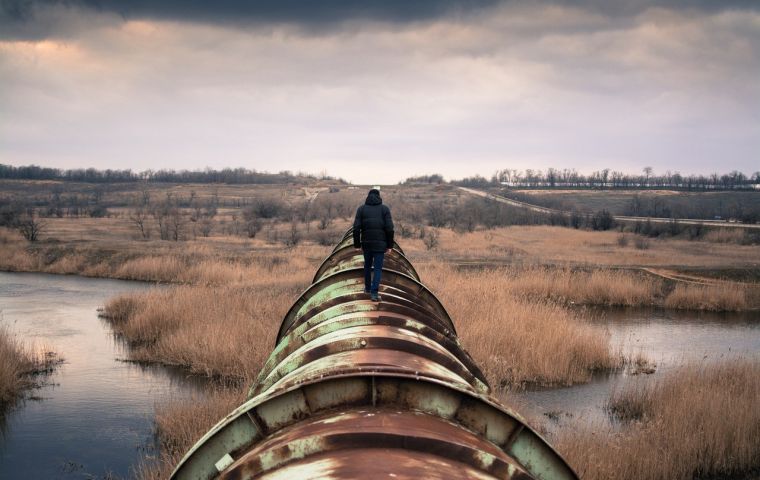MercoPress. South Atlantic News Agency
Climate change is increasingly notorious and alarming
 According to the World Bank, the losses linked to natural disasters will amount to 520 billion dollars a year and will drag 26 million people into poverty annually.
According to the World Bank, the losses linked to natural disasters will amount to 520 billion dollars a year and will drag 26 million people into poverty annually. The global climate perspective is darkened by a climate change that has accelerated in recent years and is becoming increasingly difficult to reverse. The ambitious temperature limits established in the Paris agreement are about to be overcome. Among its consequences, it is revealed that at least 26 million people will be dragged into poverty annually due to climatic causes and the retreat of the ice in the poles and mountain glaciers accelerates exponentially.
In a report published by the AFP it is revealed that the main indicators of climate change show the urgency of acting after overcoming several consecutive heat records in recent years.
The planet beat its third consecutive annual heat record in 2016, with a temperature higher than around 1.1ºC compared to the average of the pre-industrial era, according to the World Meteorological Organization (WMO).
The 21st century already has 16 of the 17 warmest years since the beginning of the temperature record in 1880.
In the Arctic, the summer ice extension of 2016 was the second smallest ever recorded (4.14 million km2, behind that of 2012). In some regions of Russia, the temperature was 6ºC or 7ºC higher than normal.
At the other border of the Earth, in Antarctica, the ice sheet lost in the austral spring (November) almost 2 million km2 compared to the average of the last 30 years: it was 14.5 million km2 in 2016 and 16.35 million between 1981 and 2010.
The melting of the glaciers in the Alpine massif continued for the 36th consecutive year.
Large cities, due to the effect of the “heat islands” generated by concrete and asphalt, could gain up to an additional 8°C by 2100.
And even if the rise to 2ºC is limited -the goal of the Paris Agreement- cities such as Jakarta, Lagos, Caracas or Manila will exceed the threshold of “lethal heat” during the middle of the year.
The concentration of the three main greenhouse gases -carbon dioxide (CO2), methane and nitrous oxide- reached new highs in 2016.
”While in 2015 it was 400 parts per million (ppm), the proportion of carbon dioxide in the atmosphere (...) reached 403.3 ppm in 2016“ and ”now represents 145% in relation to the pre-industrial era”, according to the WMO. It is the highest level in 800,000 years.
Greenhouse gas emissions from fossil fuels should stabilize in 2016 for the third year in a row, an unprecedented development linked to China's efforts, but still insufficient, according to the balance of the Global Carbon Project scientists.
Researchers have also warned of a sudden and unexplained boom in methane, which has a greater greenhouse effect than CO2.
The level of the oceans continues to rise. According to a recent study, the phenomenon, which was thought to be gradual to date, seems to accelerate: the level of the seas has grown between 25 and 30% faster from 2004 to 2015 than during the period 1993-2004.
This increase could intensify as glaciers and ice sheets melt (Antarctica, Greenland).
The rise is faster at some points, such as the Pacific and Indian Oceans.
Warming favors extreme weather events, particularly droughts and heat waves, says a WMO study.
According to some climatologists, the volume of droughts, forest fires, floods and hurricanes due to climate changes has doubled since 1990.
The violence of typhoons in China, Taiwan, Japan and the two Koreas should increase, according to a study that indicates that in the last 35 years, typhoons that have hit east and southeast Asia have gained between 12 and 15% of intensity.
At the same time, the frequency of extreme storms has tripled in the Sahel due to global warming, warns another study.
Although the rise in global temperatures is limited to 2ºC, the deadly heat waves will become more frequent, especially in the tropics.
According to the World Bank, the losses linked to natural disasters will amount to 520 billion dollars a year and will drag 26 million people into poverty annually.
Of the 8,688 threatened or nearly threatened species, 19% (1,688) are affected by climate change, both by the temperatures and by the extreme phenomena that this entails.
The Great Barrier Reef has recorded its worst bleaching episode for the second consecutive year. In addition, corals that have been affected two years in a row will not be able to recover, according to Australian scientists.
An increase in temperatures above 1.5°C, an ambitious limit included in the Paris Agreement together with that of 2°C, would also bring about an alteration of the ecosystems of the Mediterranean basin unprecedented in 10,000 years.





Top Comments
Disclaimer & comment rulesCommenting for this story is now closed.
If you have a Facebook account, become a fan and comment on our Facebook Page!